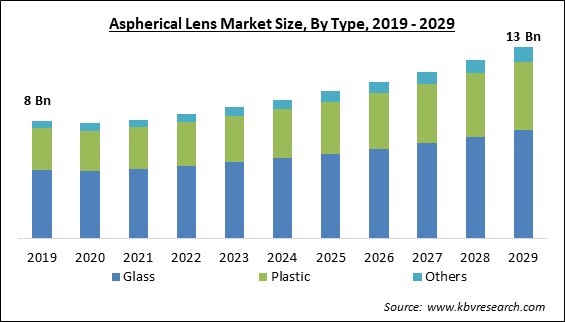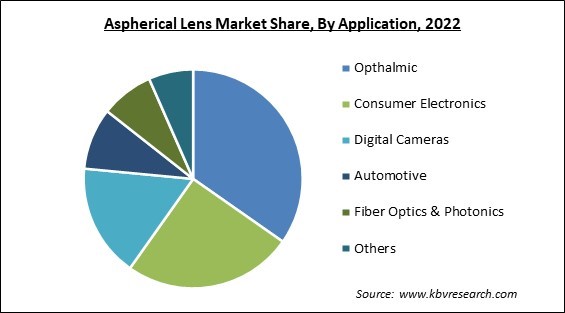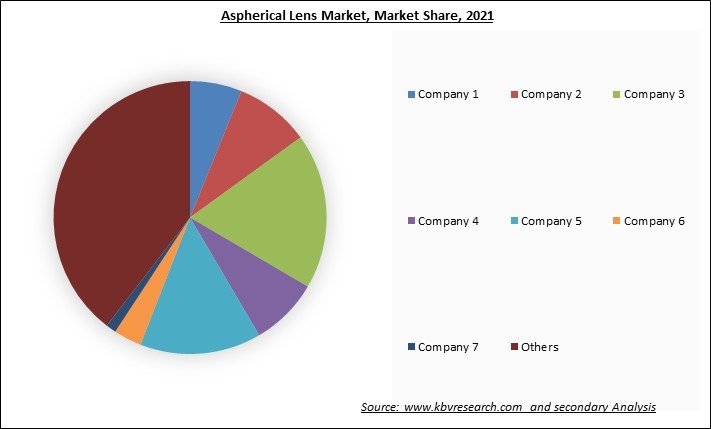The Global Aspherical Lens Market size is expected to reach $13 billion by 2029, rising at a market growth of 6.4% CAGR during the forecast period.
A lens is called an aspheric lens or asphere if the surface profiles are not entirely sphere- or cylinder-shaped. An aspheric element-containing lens assembly is commonly called an aspherical lens in photography. Comparing an asphere to a basic lens, spherical aberration and other optical distortions like astigmatism can be reduced or eliminated.

A far more intricate multi-lens system can frequently be replaced by a single aspheric lens. Compared to the multi-lens design, the final product is sometimes cheaper and smaller. Wide-angle and fast normal multi-element lenses are made with aspheric elements to minimize aberrations. Additionally, they're employed in conjunction with reflecting components (catadioptric systems), like the aspherical Schmidt corrector plate found in Schmidt cameras and Schmidt-Cassegrain telescopes. For collimating diode lasers, small molded aspheres are usually utilized.
There are situations when aspheric lenses are utilized in eyeglasses. When looking in directions other than the optical center of the lens, aspheric eyeglass lenses provide sharper vision than conventional "best form" lenses. Additionally, anisometropia may be helped by reducing the lens' magnifying impact. They might provide a smaller lens, unrelated to optical quality, and distort the viewer's eyes less when seen by other people, leading to a better aesthetic appearance.
Any material, including Trivex and polycarbonate, can create this lens. They can enhance how light reflects onto the retina while enabling users to wear a lighter, less-curved material because of their unique, non-spherical construction. Most suitable individuals using aspherical lenses are those with higher-order refractive defects, often +4.00 diopters or more. This type of lens is also used in reading glasses or contact lenses to provide clearer vision to as many individuals as possible. Refractive error management strategies include using aspherical intraocular lenses (IOLs) inserted during cataract surgery.
Uncertainties surrounding COVID-19 still have an impact on consumer confidence. Furthermore, Consumers have continued to exercise greater caution and have reduced their expenditure on necessities rather than luxuries. Disruptions to the world's supply chains are occurring. Well-known manufacturers of cell phones and other consumer goods closed their factories in China in February 2020. For consumer electronics manufacturers, the bottlenecks in producing handsets and introducing new products were shortages of components, closures of factories, quarantine regulations, logistics, and travel restrictions. All these factors halted the growth of the aspherical lens market during the projection period.
Aspherical lenses in eyeglasses can provide a wider field of view, less distortion, and a flatter appearance than traditional spherical lenses. When used with contact lenses, an aspherical shape can reduce aberrations and enhance clarity, particularly in dim lighting. To improve the visual results for patients after cataract surgery, aspherical surfaces can be included in intraocular lenses (IOLs), increasing contrast sensitivity and reducing reflection. The market for aspherical lenses is expanding due to rising rates of eye conditions such as presbyopia, myopia, and cataracts, as well as rising demand for sophisticated vision-correction tools and technological developments in lens production methods.
An IR aspherical lens may capture crisper images even in complete darkness because it transmits more infrared light than a regular lens. When it's important to capture different images of intruders or suspicious activities, this is very helpful in security and surveillance applications. The lenses serve as sensors that sound alarms in the case of a break-in or crime, deterring thieves. These lenses help identify suspects quickly without letting the target know where the camera is pointing right now. In light of this, the aspherical lens market will grow over the forecast period.
The requirement for cutting-edge manufacturing techniques, tools, and labor may raise the cost of production. To attain the required accuracy and performance, such lenses must also be made of cutting-edge materials, such as high-quality glass or certain polymers. These materials can be pricey, pushing the lens's price. Thus, aspherical lenses' high price may prevent some applications from utilizing them, especially in industries sensitive to pricing, like consumer electronics, wherein the price is a key consideration. Thus, the high cost of producing these lenses may hinder market expansion in the near future.
Based on type, the aspherical lens market is characterized into glass aspherical lens, plastic aspherical lens, and others. In 2022, the plastic aspherical lenses segment covered a considerable revenue share in the aspherical lens market. Spherical aberration, a typical problem with conventional spherical lenses, is minimized using plastic aspherical lenses. This improves the image's clarity and quality, especially around the corners. In addition, plastic aspherical lenses are frequently lighter and more portable compared to conventional spherical lenses, which might make them simpler to handle and transport.

On the basis of offering, the aspherical lens market is classified into single aspherical lens and double aspherical lens. The single aspherical lens segment witnessed the largest revenue share in the aspherical lens market in 2022. Single aspherical lenses are often utilized in camera lenses, eyewear, and other optical systems where aberrations must be corrected. Because fewer lens elements and a simpler design for a single aspherical lens make it easier to manufacture and less expensive. Market expansion is being driven by expanding R&D efforts and rising demand for such lenses.
By manufacturing technology, the aspherical lens market is divided into molding, polishing & grinding, and others. The molding segment dominated the aspherical lens market with the maximum revenue share in 2022. The molding method has the benefit of making complex, high-precision aspherical lenses quickly and effectively, which is very helpful for mass manufacturing. Lenses are produced using precision glass molding for various uses, including high-end medical devices, cell phones, and cameras. The high-thermal stability aspherical lens market is expanding due to rising consumer demand.
Based on application, the aspherical lens market is segmented into consumer electronics, digital cameras, automotive, ophthalmic, fiber optics & photonics, and others. In 2022, the consumer electronics segment recorded a remarkable revenue share in the aspherical lens market. Smartphone makers can enhance the quality of the images and lessen distortion in the pictures captured by their cameras by utilizing aspherical lenses. Additionally, aspherical lenses can help the camera module become lighter and smaller, which makes it simpler to incorporate into the small-footprint designs of contemporary smartphones. Aspherical lenses are in high demand due to the increasing desire for better image quality from smartphone cameras.
| Report Attribute | Details |
|---|---|
| Market size value in 2022 | USD 8.5 Billion |
| Market size forecast in 2029 | USD 13 Billion |
| Base Year | 2022 |
| Historical Period | 2019 to 2021 |
| Forecast Period | 2023 to 2029 |
| Revenue Growth Rate | CAGR of 6.4% from 2023 to 2029 |
| Number of Pages | 254 |
| Number of Table | 460 |
| Report coverage | Market Trends, Revenue Estimation and Forecast, Segmentation Analysis, Regional and Country Breakdown, Market Share Analysis, Companies Strategic Developments, Company Profiling |
| Segments covered | Offering, Type, Manufacturing Technology, Application, Region |
| Country scope | US, Canada, Mexico, Germany, UK, France, Russia, Spain, Italy, China, Japan, India, South Korea, Singapore, Malaysia, Brazil, Argentina, UAE, Saudi Arabia, South Africa, Nigeria |
| Growth Drivers |
|
| Restraints |
|
Region wise, the aspherical lens market is analyzed across North America, Europe, Asia Pacific, and LAMEA. In 2022, the Asia Pacific region led the aspherical lens market by generating the highest revenue share. This is because aspherical lenses are used more often in various industries, including ophthalmology, digital photography, fiber optics & photonics, and driverless vehicles. The market expansion in this region is also anticipated to be fueled by the rising demand for aspherical lenses in Japan, China, and South Korea and the expanding use of aspherical lenses in ophthalmology and self-driving vehicle technologies.
Free Valuable Insights: Global Aspherical Lens Market size to reach USD 13 Billion by 2029

The leading players in the market are competing with diverse innovative offerings to remain competitive in the market. The illustration shows the percentage of revenue shared by some of the leading companies in the market. The leading players of the market are adopting various strategies in order to cater demand coming from the different industries. The key developmental strategies in the market are Acquisitions, and Partnerships & Collaborations.
The market research report covers the analysis of key stake holders of the market. Key companies profiled in the report include Nikon Corporation, Canon, Inc., Panasonic Holdings Corporation, Hoya Corporation, Thorlabs, Inc., AGC, Inc., Carl Zeiss AG, Tokai Optical Co., Ltd., Calin Technology Co., Ltd. and Largan Precision Co., Ltd.
By Offering
By Type
By Manufacturing Technology
By Application
By Geography
The Market size is projected to reach USD 13 billion by 2029.
Growing use in optical instruments & ophthalmic applications are driving the market in coming years, however, High cost of manufacturing aspherical lenses restraints the growth of the market.
Nikon Corporation, Canon, Inc., Panasonic Holdings Corporation, Hoya Corporation, Thorlabs, Inc., AGC, Inc., Carl Zeiss AG, Tokai Optical Co., Ltd., Calin Technology Co., Ltd. and Largan Precision Co., Ltd.
The Glass segment acquired maximum revenue share in the Global Aspherical Lens Market by Type in 2022 thereby, achieving a market value of $7.4 billion by 2029.
The Asia Pacific market dominated the Market by Region in 2022, and would continue to be a dominant market till 2029; thereby, achieving a market value of $5 billion by 2029.
Our team of dedicated experts can provide you with attractive expansion opportunities for your business.

